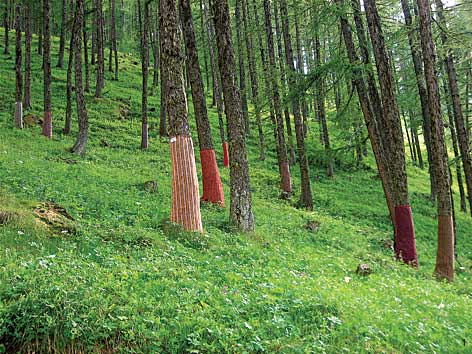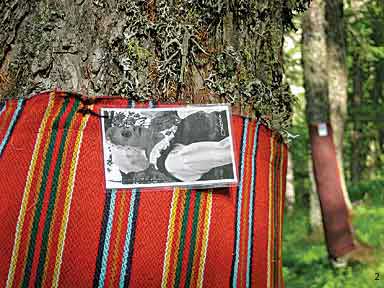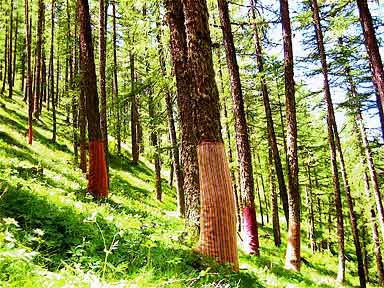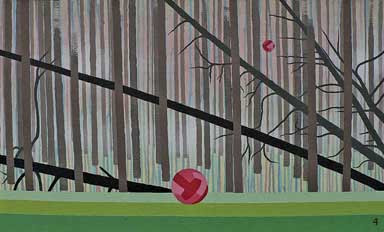| |
An Estonian sculptress on the trail of the Crévoux fairies, in the Hautes Alpes region
Nicolas Boldich
 Estonia’s forests are one of the main assets of this flat Baltic country. They represent economic wealth, certainly, but also and above all they are symbolic. In this place, where the salt water of the sea meets the earth, a huge, rolling and intricate forest begins. The Estonian forest is a national temple, a sanctuary in which, according to popular belief, the spirits of the ancestors rest; these spirits, which are “reincarnated” in the form of “tamm” (oaks), “vahtra” (maple trees), and so forth, can cover themselves in greenery, flower and be reborn every spring. Estonia’s forests are one of the main assets of this flat Baltic country. They represent economic wealth, certainly, but also and above all they are symbolic. In this place, where the salt water of the sea meets the earth, a huge, rolling and intricate forest begins. The Estonian forest is a national temple, a sanctuary in which, according to popular belief, the spirits of the ancestors rest; these spirits, which are “reincarnated” in the form of “tamm” (oaks), “vahtra” (maple trees), and so forth, can cover themselves in greenery, flower and be reborn every spring.
The Estonian forest, which the local population has always regarded in reverential dread, has also become the subject matter of an ecological wager in recent decades by a population that is used to living its deep love of nature; a nature elevated to the rank of symbol.
Even if the Hautes Alpes forests are made differently; sloping and with wide diagonal rays of light. Even if the scents you can breathe in are not the same, and a circle of larches on a slope in the Crévoux valley in the Hautes Alpes region are clearly very different from the Estonian forest (which stands hieratic, like a barrier formed by the masts of a ship whose sullen sails are weighed down by snow; snow that is nowadays rarer and rarer). Despite all this, the presence of fairies are a common denominator that unites them from one end to the other of the European continent.
Let’s start from the larches, trees with soft wood and scented resin, whose name means “mild”. In the Briançonnais region, a few dozen kilometres from Crévoux, this resin was actually “manna”, a sprinkling of “sparks” released from these high mountain conifers. The manna from the larches is one of the items in the canonical list of the “Marvels of the Dauphiné” that we have already mentioned. Marvels that reach no more and no less than seven in number. If the Grenoble region and Trièves (in the southern part of Isère) are the locations of the first six marvels, such as Roche Percée (la Roccia Perforata) or Mont Aiguille (Mount Needle) (where some people in the middle ages believed that an earthly paradise was located), there was always this land in the south of Dauphiné, in particular in Briançonnais, which has always been contested by the Piedmont and the Kingdom of France, and where it is possible to admire the seventh wonder, in other words the manna.
Many scholars, writers and ecclesiastical people were interested in this rain of light that emanated from the forest of larches, and they advanced the most disparate theories about it, until this magic phenomena was explained in the century of positivism. The manna from the larches, these trees with saggy, wobbly and forked branches, and long needle like leaves, were no more than white and sticky granules, the result of pollination of the deciduous branches of the trees by a species of migratory bee. The myth had evolved into a natural phenomena.
Van Gennep knew how to emphasise the rich folklore of Dauphiné, to which he dedicated a lot of study. The alpine population could dedicate long winters in developing never ending themes regarding werewolves, sortileges and fairies that, according to the tales, had even contributed to developing the landscape. You can find the same thing in the Baltic and in particular in Estonia, where scholars of German, Finnish and Soviet folklore have, at different times, researched a wealth of information with an exceptional level of detail. In this small country, werewolves, fairies, little demons and other kobolds are particularly active, if you believe the many tales, songs and narrations that, like the endless threads of the woof and fabric of a patiently weaved tapestry, give life to an epic national canto called Kalevipoeg. Thus, put together, they create that series of epic imagery that define the soul of Estonia.
This Estonia is truly a land of “madness” and “mad people”! Just like the other alpine territories, in particular in the high–up village of Saint-Véran, where even now the stars and other primitive themes of an almost magical innocence are humbly preserved in the architecture and sculptures made from carved wood.
The fairies make you become “a little mad”.
The trail of the fairies is the name of the event that has been held in the last three years in the Crévoux valley, which is located between the Durance and Ubaye valleys, a few kilometres from Embrun and close to Briançonnais and its manna. You need courage to hold an open air festival in a rustic and natural setting but each year it attracts an increasingly large number of visitors (last year they numbered 15.000). There are shows and educational events, and the organisers propose a new approach to contemporary art, especially for schools. Works of art are no longer in an urban context but are instead immersed in nature. It’s a way to catch two birds with one stone in a kind of two way exercise: attract art towards nature and attract nature towards art.
Art must make us to see an environment which, however beautiful it is, is often travelled across as if it were a simple ornamental accessory. Here we are invited to stop, admire and discover the signs which attract each other along the Crévoux trail.
There is a large space dedicated to Land Art and sculptures in the open air, while different skills permeate the in situ works of groups of artists who work there all year round, as well as the six artists who were invited this year (for a period of two to three weeks between 5 and 28 June). Some interactive digital devices, provided by the municipality of Crévoux, round off the works of art of artists who collectively constitute a voyage through contemporary art.
Aili Vahtrapuu, who is from a small town in Estonia, is one of the six selected guest artists for this year. She is working on the “Striscia tonda” (Round Stripe) project.
Vahtrapuu (which in Estonian means “maple”) started her artistic career depicting a ship, not trees or forests; a ship with an extremely light hull and coloured sails that would still be visible today on the endless beach of Pirita, in Tallinn, if it had been accepted by a jury. This was in 1980.
The boat, which was meant to symbolise the Olympic regatta of 1980, the first and only Olympics in the Soviet era, unfortunately never saw the light of day. It has remained in draft format in the artist’s portfolio. The political authorities at that time found this dynamic, multi-coloured sculpture too audacious, light and stimulating to travel, or perhaps to run away…
 Sails and masts later appeared once more in the graphic works of Aili Vahtrapuu, in the shape of taut lines, with features that transform the sail into an ensemble of shrouds and sails, a metaphor of lightness and movement. A work of art which won her an award in Osaka in Japan. The Japanese were no doubt struck by the Asian refinement of her compositions, in particular her wooden masks with black lines carved into them, that have the purity and severity of shamanic masks which you could expect to see in some corner of a forest. Wood also appears in other works of art by Vahtrapuu in the form of coloured panels. Sails and masts later appeared once more in the graphic works of Aili Vahtrapuu, in the shape of taut lines, with features that transform the sail into an ensemble of shrouds and sails, a metaphor of lightness and movement. A work of art which won her an award in Osaka in Japan. The Japanese were no doubt struck by the Asian refinement of her compositions, in particular her wooden masks with black lines carved into them, that have the purity and severity of shamanic masks which you could expect to see in some corner of a forest. Wood also appears in other works of art by Vahtrapuu in the form of coloured panels.
The Estonians are woodmen or sailors. Hemingway often recounted that he always met Estonian sailors in the ports he visited. There are many Estonians who have sailed towards the Americas and Australia. From their part, the woodmen have provided the basic material for the construction of traditional dwellings, some examples of which have survived in the heart of Tallinn, the country’s capital. A country with two poles: a maritime one and a land one. Two poles that we can find in Vahtrapuu’s works of art; in which she often uses the seas of Freemantle, Norway and Tallinn. She uses these coastal localities, the element of water, the architecture of the ports or on the musical sound of the rain, drawing from the Estonian hinterland, with its context of rocky scenery, and ragged landscape of trees which were the propitiators of Land Art. Music, flow and lightness are her omnipresent themes, as well as woods, masks and forests, both the traditional ones formed by trees or more particular ones made up of urban noise, which we find in some of her creations.
This time this artist, with her “Striscia tonda” (round stripe) project, has gone back to the theme of the land, to the humus of the original forests. Tree trunks and real trees have substituted the masts on ships. However, by underlining the tubular structure of trees, Vahtrapuu invents new constructions halfway between natural and artificial ones. I found these real trees/masts of ships in the imagery of a friend, artist and painter, R. Boisbourdin, who followed the opposite route to Aili Vahtrapuu: from France to Estonia.
Stripes of colour run along the trunks, while by contrast downed trees underline the verticality of the columns of that natural sanctuary which is the island of Hiumaa. This image draws from Vahtrapuu’s previous imagery so faithfully that you cannot but think that the Baltic forest spoke to her; a forest that may be the ancestor of our own forests, one that is still inhabited by forces that are both supernatural and human.
It is this forest that, dressed up with Estonian clothes, was present last June on the mounts of the valleys of Crévoux, side by side with other signs placed by guest artists. 
The folkloristic article of clothing that covers the trunks of trees is in fact made from linen, a material that was once exported to France from Baltic ports (Lubecca, Riga, and Tallinn-Reval). Other vessels full of products from the land and forests of Livonia (from the people of ancient Livonia, a country on the borders of modern day Estonia and Lettonia), or from Curlandia, would also be exported from these ports.
In the age of Luigi XIV stripes were fashionable. It was from Lubecca, on the Baltic Sea, that cloth with stripes was exported to Estonia, where it was used until the XIX century to package clothes for country people. Each Parish at that time had a particular scheme with stripes; the stripes represented a sign of belonging and identity. Just like the bark, the trunk or the sapwood of a tree permit the identification of the species, the stripes on the clothes of an Estonian peasant meant that it was possible to recognise the Parish they “belonged to”. Nothing was left to chance: the people who knitted these stripes actually recounted tales through the colours and shades. One colour in particular dominated the others: “kiri” (which was used for letters). This is how the population lived in the country in an age in which, under the reign of the Junkers, Estonian peasants were practically reduced to being a mere element of noble wealth, or almost.
The linen and stripes have taken a route that traces a historical one. After leaving France, the stripes return there, while Estonian peasants –as this country population was called in the XIX century – were reincarnated in the larches of the Crévoux valleys.
Part of the folkloristic and European, natural and magic, signs that it was possible to read this June in the third trail of the fairies, in Crévoux, in the Hautes Alpes region.
Text translated from French
The address of the festival for those interested in it, including artists in particular, is the following:
Fate d’inverno (Winter fairies), Champ Rond - 05200 Crévoux
Blog by Rémi Boisbourdin: http://nature-renversee.blogspot.com/
The web-site of the “Striscia tonda” (round stripe) project is the following:http://aili.pri.ee/
- 1 .Aili Vahtrapuu - Rayures rondes, 2008
- 2. Aili Vahtrapuu - Rayures rondes, 2008
- 3. Aili Vahtrapuu - Rayures rondes, 2008
- 4. Rémi Boisbourdin - Jalgpalliga, 2008
|
|